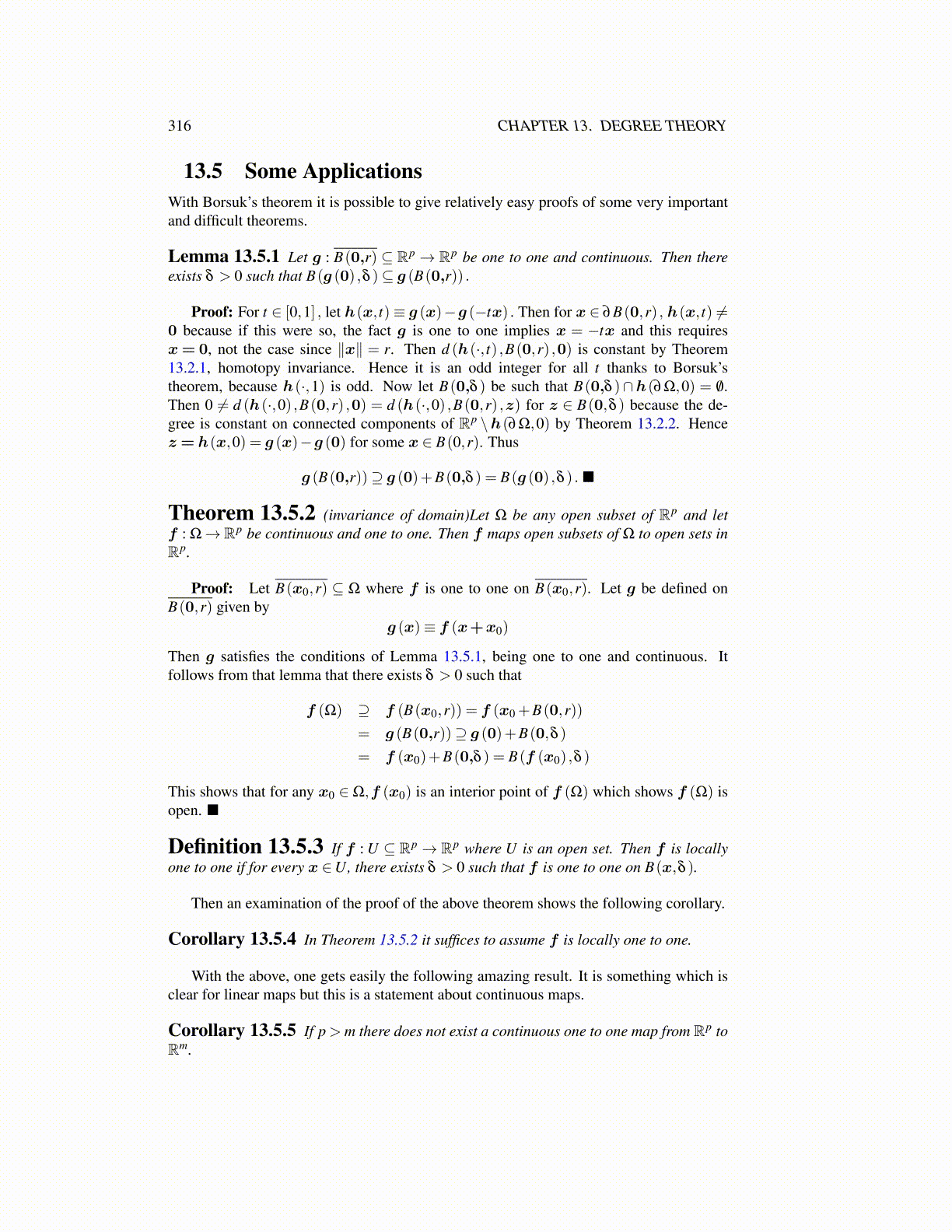
316 CHAPTER 13. DEGREE THEORY
13.5 Some ApplicationsWith Borsuk’s theorem it is possible to give relatively easy proofs of some very importantand difficult theorems.
Lemma 13.5.1 Let g : B(0,r) ⊆ Rp → Rp be one to one and continuous. Then thereexists δ > 0 such that B(g (0) ,δ )⊆ g (B(0,r)) .
Proof: For t ∈ [0,1] , let h(x, t)≡ g (x)−g (−tx) . Then for x ∈ ∂B(0,r) , h(x, t) ̸=0 because if this were so, the fact g is one to one implies x = −tx and this requiresx= 0, not the case since ∥x∥ = r. Then d (h(·, t) ,B(0,r) ,0) is constant by Theorem13.2.1, homotopy invariance. Hence it is an odd integer for all t thanks to Borsuk’stheorem, because h(·,1) is odd. Now let B(0,δ ) be such that B(0,δ )∩h(∂Ω,0) = /0.Then 0 ̸= d (h(·,0) ,B(0,r) ,0) = d (h(·,0) ,B(0,r) ,z) for z ∈ B(0,δ ) because the de-gree is constant on connected components of Rp \h(∂Ω,0) by Theorem 13.2.2. Hencez = h(x,0) = g (x)−g (0) for some x ∈ B(0,r). Thus
g (B(0,r))⊇ g (0)+B(0,δ ) = B(g (0) ,δ ) . ■
Theorem 13.5.2 (invariance of domain)Let Ω be any open subset of Rp and letf : Ω→ Rp be continuous and one to one. Then f maps open subsets of Ω to open sets inRp.
Proof: Let B(x0,r) ⊆ Ω where f is one to one on B(x0,r). Let g be defined onB(0,r) given by
g (x)≡ f (x+x0)
Then g satisfies the conditions of Lemma 13.5.1, being one to one and continuous. Itfollows from that lemma that there exists δ > 0 such that
f (Ω) ⊇ f (B(x0,r)) = f (x0 +B(0,r))
= g (B(0,r))⊇ g (0)+B(0,δ )
= f (x0)+B(0,δ ) = B(f (x0) ,δ )
This shows that for any x0 ∈ Ω,f (x0) is an interior point of f (Ω) which shows f (Ω) isopen. ■
Definition 13.5.3 If f : U ⊆ Rp → Rp where U is an open set. Then f is locallyone to one if for every x ∈U, there exists δ > 0 such that f is one to one on B(x,δ ).
Then an examination of the proof of the above theorem shows the following corollary.
Corollary 13.5.4 In Theorem 13.5.2 it suffices to assume f is locally one to one.
With the above, one gets easily the following amazing result. It is something which isclear for linear maps but this is a statement about continuous maps.
Corollary 13.5.5 If p > m there does not exist a continuous one to one map from Rp toRm.